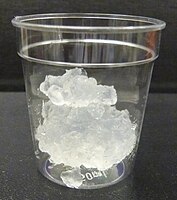
Photo from wikipedia
Abstract To improve the bonding strength between polypropylene (PP) fibres and concrete, this study investigates a new method of modifying the surface by grafting hydrophilic groups and silane groups on… Click to show full abstract
Abstract To improve the bonding strength between polypropylene (PP) fibres and concrete, this study investigates a new method of modifying the surface by grafting hydrophilic groups and silane groups on PP fibres. Characterisation of fibre modification, fibre pullout performance from concrete, and flexural behaviour of fibre reinforced ultra-high performance concrete (UHPC) were studied. From the Fourier transform infrared (FTIR) and water contact angle measurements, both the hydrophilic groups and silane groups demonstrated successful and efficient surface grafting on the PP fibres, which helped to improve the bonding behaviour of the grafted fibres. The silane groups and hydrophilic groups grafted PP fibres showed significant improvement in the bond behaviour, in which the pullout forces were approximately 3.0 and 1.6 times of unmodified PP fibres, respectively. The energy absorption of the modified fibres, estimated from the pullout tests, showed an increase by 121% and 80% for silane groups and hydrophilic groups, respectively. The silane groups grafted PP fibre reinforced UHPC showed outstanding toughness and deflection-hardening performance, which increased by 97% as compared to those of unmodified fibres. The flexural performance of 27 kg/m3 silane groups grafted PP fibre reinforced UHPC was comparable with the 78 kg/m3 steel fibre reinforced UHPC.
Journal Title: Construction and Building Materials
Year Published: 2021
Link to full text (if available)
Share on Social Media: Sign Up to like & get
recommendations!